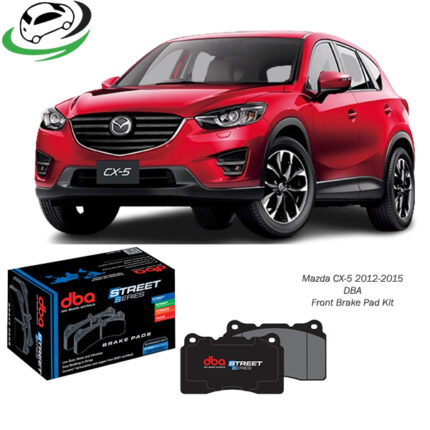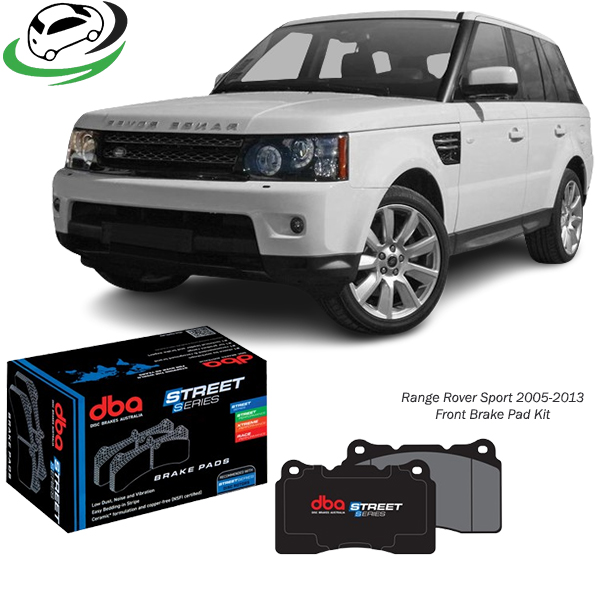-12%
Get Range Rover Sport 2005-2013 Front Brake Pad Kit Street Performance DB2073SS
A brake pad kit is an essential component of a vehicle’s braking system. It includes the brake pads themselves, along with various hardware components needed for installation and optimal performance. Understanding the intricacies of a brake pad kit, its components, functions, and importance can help in making informed decisions when it comes to vehicle maintenance and safety.
Components of a Brake Pad Kit
- Brake Pads: The primary component of the kit, brake pads are the friction material that presses against the brake rotor to slow down or stop the vehicle. They are typically made of composite materials such as semi-metallic, ceramic, or organic compounds.
- Shims: These thin layers of rubber or metal are placed between the brake pad and the caliper to reduce noise and vibration. Shims help in providing a smooth and quiet braking experience.
- Caliper Hardware: This includes clips, pins, and springs that hold the brake pads in place within the caliper. These components ensure that the brake pads move correctly and retract properly after braking.
- Wear Indicators: Some kits come with wear indicators, which are either mechanical or electronic sensors that alert the driver when the brake pads need replacement.
- Lubricants: High-temperature grease is often included to lubricate the caliper hardware and contact points, preventing squeaks and ensuring smooth operation.
- Instructions: Detailed instructions for installing the brake pads and associated hardware, ensuring that even those with basic mechanical skills can perform the replacement correctly.
Types of Brake Pads
- Semi-Metallic: Made from a mix of metal fibers, these pads are durable and offer good performance. They are, however, noisier and can wear down the rotors more quickly than other types.
- Ceramic: Composed of ceramic fibers and nonferrous materials, these pads are quieter and produce less dust. They are ideal for high-performance applications but can be more expensive.
- Organic: Made from natural materials such as glass, rubber, and resins, organic pads are quieter and produce less dust. They are generally less durable and offer lower performance than semi-metallic or ceramic pads.
Benefits of brake pad kits
1. Enhanced Safety
- Consistent Braking Performance: High-quality brake pads provide consistent and reliable braking power, essential for safe driving. This reliability is critical during emergency stops and adverse driving conditions.
- Reduced Risk of Brake Failure: Replacing old and worn-out brake pads with new ones from a kit reduces the risk of brake failure, ensuring the vehicle stops effectively when needed.
2. Comprehensive Components
- All-in-One Solution: Brake pad kits include not just the brake pads but also essential hardware components such as shims, clips, pins, and sometimes wear indicators. This comprehensive approach ensures all necessary parts are available for a complete replacement.
- Improved Compatibility: Kits are designed to match specific vehicle makes and models, ensuring all parts fit perfectly and work together seamlessly.
3. Improved Performance
- Optimal Friction Material: Brake pad kits typically feature advanced friction materials (e.g., ceramic, semi-metallic, organic) that provide excellent stopping power, durability, and heat dissipation.
- Noise and Vibration Reduction: Many kits include shims and other noise-dampening components that reduce brake noise and vibrations, resulting in a smoother and quieter braking experience.
- Enhanced Heat Dissipation: Advanced materials and designs in brake pads help dissipate heat more effectively, reducing the risk of brake fade during prolonged or intense braking.
4. Cost-Effectiveness
- Bundled Savings: Purchasing a brake pad kit is often more cost-effective than buying each component separately. Kits provide all necessary parts at a lower overall cost, offering better value for money.
- Reduced Maintenance Costs: Regularly replacing brake pads and associated hardware can prevent more severe damage to the braking system, avoiding expensive repairs and replacements in the long run.
5. Ease of Installation
- Complete Instructions: Kits often come with detailed instructions, making the installation process straightforward even for those with basic mechanical skills.
- Convenience: Having all necessary parts in one package simplifies the replacement process, saving time and effort compared to sourcing individual components separately.
6. Prolonged Component Life
- Uniform Wear: Replacing all related hardware along with the brake pads ensures uniform wear and tear, extending the life of the braking system components.
- Optimal Functioning: New hardware components such as clips and pins ensure the brake pads move correctly and retract properly, maintaining the optimal functioning of the braking system.
7. Environmental Benefits
- Reduced Waste: Using a brake pad kit ensures that all worn components are replaced together, reducing the likelihood of multiple replacements over time and minimizing waste.
- Improved Emissions: High-quality brake pads reduce brake dust and emissions, contributing to a cleaner environment. This is particularly important in urban areas where air quality can be significantly impacted by vehicle emissions.
8. Technological Advancements
- Modern Materials and Design: Kits from reputable manufacturers incorporate the latest advancements in materials and design, including better heat dissipation, noise reduction technologies, and materials that offer superior performance and longevity.
- Compatibility with Advanced Systems: Modern vehicles often come equipped with advanced braking systems like ABS (Anti-lock Braking System) and electronic stability control. A well-designed brake pad kit ensures compatibility with these systems, maintaining their effectiveness and safety benefits.
9. Improved Driving Experience
- Smoother Braking: New brake pads and hardware components provide smoother braking, reducing the jerkiness often associated with worn-out pads.
- Quieter Operation: Components such as shims and anti-vibration clips reduce noise during braking, enhancing the overall driving experience.
10. Reliability
- High-Quality Standards: Reputable manufacturers ensure that brake pad kits meet or exceed industry standards, providing reliable and consistent performance.
- OEM Approvals: Many brake pad kits carry Original Equipment Manufacturer (OEM) approvals, indicating they meet the specific requirements of various vehicle manufacturers and adding an extra layer of assurance for consumers.
signs of worn-out brake pads
1. Squealing or Squeaking Noises
- High-Pitched Sound: A high-pitched squealing or squeaking noise when applying the brakes is often a sign of worn brake pads. This noise is typically caused by a built-in wear indicator that alerts the driver when the pads are nearing the end of their useful life.
- Persistent Noise: If the noise persists even when the brakes are not applied, it could indicate that the pads are completely worn down and metal-to-metal contact is occurring.
2. Grinding Sound
- Metallic Grinding: A grinding or growling noise when braking is a more serious sign. This typically indicates that the brake pads are completely worn out, and the metal backing plate is coming into contact with the rotor. This can cause significant damage to the rotors and reduce braking efficiency.
3. Reduced Brake Performance
- Longer Stopping Distances: If you notice that your vehicle is taking longer to stop than usual, it could be a sign that the brake pads are worn and not providing adequate friction.
- Increased Pedal Pressure: Needing to apply more pressure to the brake pedal to achieve the same stopping power is another indicator of worn brake pads.
4. Vibration or Pulsation
- Vibrating Pedal: A vibrating or pulsating brake pedal, especially under normal braking conditions, can indicate unevenly worn brake pads or warped rotors.
- Steering Wheel Vibration: In some cases, the vibration may be felt in the steering wheel, suggesting issues with the front brakes.
5. Brake Pad Thickness
- Visual Inspection: You can often check the thickness of the brake pads through the wheels. If the pad material is less than 1/4 inch (about 6.35 mm) thick, it’s time for a replacement.
- Wear Indicators: Some brake pads come with wear indicators that make it easier to check pad thickness. If the indicator shows the pads are worn, replacement is necessary.
6. Indicator Lights
- Dashboard Warning Light: Many modern vehicles have electronic wear sensors that trigger a dashboard warning light when the brake pads need to be replaced. Pay attention to any brake warning lights on your dashboard.
7. Pulling to One Side
- Uneven Braking: If the vehicle pulls to one side when braking, it may indicate uneven wear on the brake pads or issues with the brake calipers. This can lead to uneven braking and reduced control.
8. Brake Dust
- Increased Dust: Excessive brake dust on your wheels can be a sign of worn brake pads. While some dust is normal, a sudden increase can indicate that the pads are wearing down rapidly.
9. Spongy or Soft Brake Pedal
- Loss of Firmness: A brake pedal that feels spongy or soft when pressed can indicate worn brake pads, air in the brake lines, or issues with the brake fluid. This reduces the effectiveness of the braking system and requires immediate attention.
10. Burning Smell
- Overheating: A sharp, burning chemical smell after hard braking can indicate that the brakes are overheating. This could be due to worn brake pads or other issues within the braking system.
Installation Process
- Preparation: Before starting, ensure the vehicle is on a flat surface and securely supported by jack stands. Gather all necessary tools, including a jack, lug wrench, C-clamp, and the brake pad kit.
- Removing the Wheel: Loosen the lug nuts on the wheel, lift the vehicle with a jack, and remove the wheel to access the brake assembly.
- Removing the Caliper: Locate the caliper bolts and remove them to free the caliper from the rotor. Secure the caliper with a piece of wire to prevent strain on the brake hose.
- Removing Old Pads: Take out the old brake pads from the caliper bracket. If necessary, use a C-clamp to compress the caliper piston back into the caliper housing, making room for the new pads.
- Installing New Pads: Place the new shims on the back of the brake pads if not pre-installed. Insert the new brake pads into the caliper bracket, ensuring they fit snugly.
- Reassembling the Caliper: Reattach the caliper over the new pads and secure it with the caliper bolts. Apply high-temperature grease to the caliper hardware as needed.
- Reinstalling the Wheel: Put the wheel back on and tighten the lug nuts by hand. Lower the vehicle and then fully tighten the lug nuts in a star pattern to ensure even pressure.
- Testing: Once everything is reassembled, test the brakes by pressing the brake pedal several times to ensure it feels firm. Conduct a slow test drive to verify proper installation and braking performance.
Maintenance Tips
- Regular Inspections: Periodically check the condition of brake pads, rotors, and caliper hardware. Look for signs of wear, cracks, or damage.
- Brake Fluid: Maintain the brake fluid at the recommended level and replace it according to the manufacturer’s guidelines. Contaminated or low brake fluid can affect braking performance.
- Cleanliness: Keep the braking system clean. Brake dust and debris can accumulate and affect the efficiency of the brake pads and rotors.
- Driving Habits: Practice gentle braking when possible to extend the life of the brake pads. Avoid hard braking unless necessary.
Follow us on Facebook for more parts.



